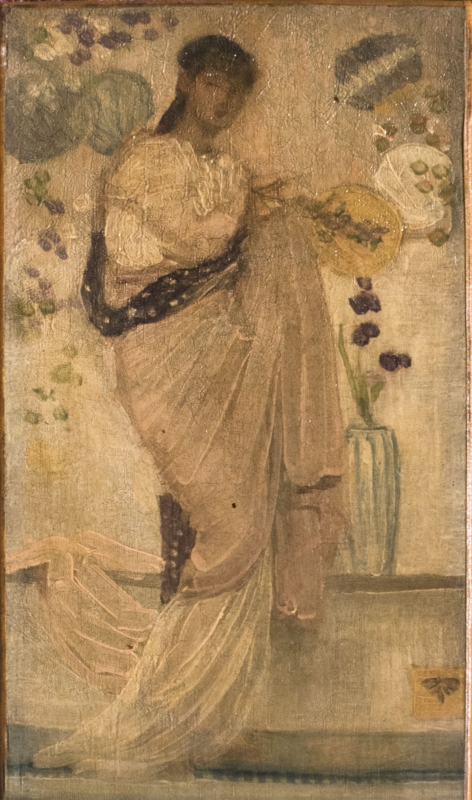Home > Catalogue > Browse > Tanagra << >>
Titles
Whistler’s own title is not known. Suggested titles include:
- 'Lady with a Japanese Fan' (1960, R. G. McIntyre). 1
- 'Tanagra' (1960, Andrew McLaren Young). 2
- 'Tanagra' (1980, YMSM). 3
- 'Sketch of a Figure with Flowers and Japanese Fans' (2014, Maier Museum). 4
To avoid confusion, the title 'Tanagra' has been retained.
The 1980 catalogue commented, 'The title "Tanagra", first suggested by McLaren Young in 1960, is taken from that given, probably by Whistler, to a related chalk drawing on brown paper in the Hunterian Art Gallery, Glasgow.' 5 However, there is no evidence that the pastel (reproduced above) was called 'Tanagra' by Whistler. It was signed about 1881/1882 and exhibited by Whistler in 1889 as Rose and Silver [M.0356]. It was some years after Whistler's death that his executrix, Rosalind Birnie Philip (1873-1958), lent the pastel to an exhibition as 'Tanagra'. 6
The term 'Tanagra' was in common use in Whistler's time, and was used to refer to certain Greek terracotta statuettes or figurines. 7 About 1894 Whistler was asked to help in the sale of a collection of such statuettes in the collection of Alexander Ionides (1840-1898). He was given an album of photographs of these figurines and copied the photograph of what he himself described as one of the 'Tanagras' or 'Tanagra figures' in the album, Sketch after a Greek terracotta figure [M.1419]. 8 The album includes a photograph of a woman holding a fan, similar in pose to the oil sketch Tanagra. 9
Whistler had a close business relationship with the art dealer Marcus Bourne Huish (1843-1904), who was an expert on these figurines and published an article on them, 'Tanagra Terra-cottas', in The Studio in 1898, and a book, Greek Terra-cotta Statuettes: Their Origin, Evolution, and Uses, in 1900. 10
Description
A small full-length study of a standing woman in vertical format. She is wearing a white robe, and her head, in three-quarter view, is tilted to her left but looking at the viewer. She stands with her right leg slightly bent, so that her body curves gently. A stole in very pale pink is clasped around her arms and the ends fall over her left arm. She has dark brown hair tied by a patterned purple scarf behind her neck; the scarf then loops across her body, and trails down at left behind her right knee. Her right arm crosses her body, with her hand adjusting the stole below her left shoulder; her left arm is not seen but her left hand holds a round palm fan.
There are several more fans on the wall, coloured in cream, pale blue, and mauve. Ochre, white, and purple petals and small green leaves are scattered across the cream and pink background. She stands on a blue and white chequered rug. Behind her is a low shelf or bench with, at right, a tall fluted vase holding purple flowers; at far right, on the front of the shelf, is a cartouche signed with a butterfly.
Sitter
Unknown.
Comments
Recent catalogues have associated the painting with Japanese art and artefacts rather than 'tanagra'. For instance the Maier Museum website (where the title of the painting has been changed from Tanagra to Sketch of a Figure with Flowers and Japanese Fans) states:
'Whistler exemplifies Western artists' interest in Japanese aesthetics. Incorporating Japanese artifacts such as fans and porcelain into his images, he also - perhaps most significantly - incorporated Japanese design sensibilities into his compositions. ...
Whistler purchased Japanese prints, fans and costumes, exemplifying Western artists' interest in Japanese aesthetics. "Sketch of a Figure with Flowers and Japanese Fans" was based on the style of Greek terra cotta figures but it is evident that Whistler’s interest in Japanese art largely influenced the outcome of the painting with the inclusion of the fan and porcelain vase.' 11
Notes:
1: R. G. McIntyre to A. McLaren Young, 25 March 1960, GUL WPP files.
2: Young, A. McLaren, James McNeill Whistler, Arts Council Gallery, London, and Knoedler Galleries, New York, 1960 (cat. no. 22).
3: YMSM 1980 [more] (cat. no. 92).
4: Maier Museum website at http://collections.maiermuseum.org.
5: YMSM 1980, op. cit.
6: Loan Exhibition of Works by James McNeill Whistler to aid the Professional Classes War Relief Council, Messrs Colnaghi, London, 1915 (cat. no. 47).
7: For a fuller account see Tanagra: Mythe et archéologie, exh. cat., Musée du Louvre, Paris, 2003. At the end of the 1860s, local inhabitants started to plunder tombs in the region of Tanagra and sold these statuettes. The figurines quickly became a popular collector's item in France and Britain.
8: See Whistler to A. Ionides, [15 August 1895], GUW #02364; Whistler to B. Whistler, [28 November 1895], GUW #06649.
9: MF Williams 1965 [more], pp. 98-99, (xiii), repr. p. 98, drawings repr. p. 96.
10: Huish, Marcus Bourne, 'Tanagra Terra-cottas', The Studio, vol. 14, 1898, pp. 97-104; Huish, Marcus Bourne, Greek Terra-cotta Statuettes: Their Origin, Evolution, and Uses, London, 1900.
11: Maier Museum website at http://collections.maiermuseum.org.
Last updated: 15th December 2020 by Margaret









